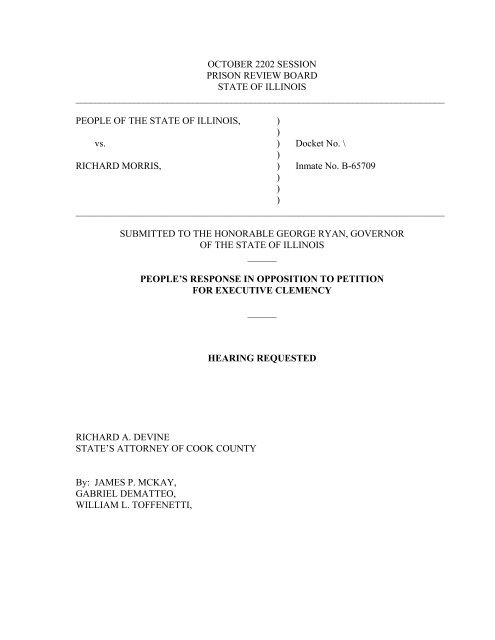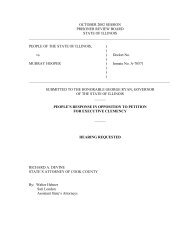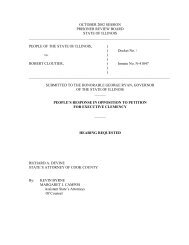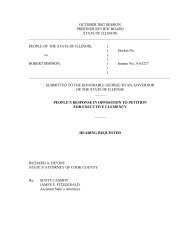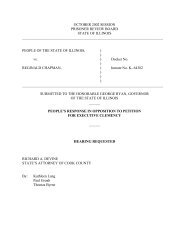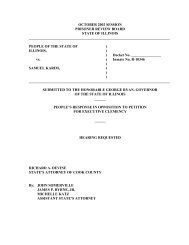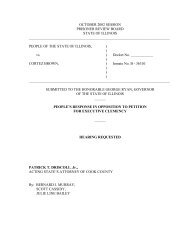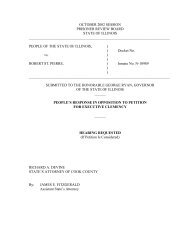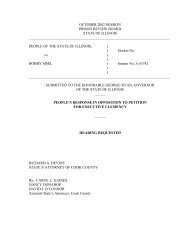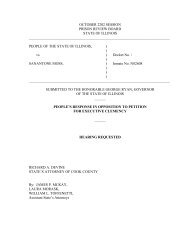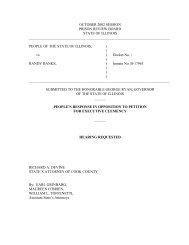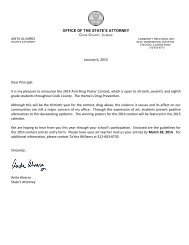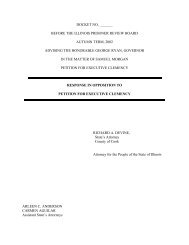Richard Morris - Cook County State's Attorney
Richard Morris - Cook County State's Attorney
Richard Morris - Cook County State's Attorney
Create successful ePaper yourself
Turn your PDF publications into a flip-book with our unique Google optimized e-Paper software.
OCTOBER 2202 SESSION<br />
PRISON REVIEW BOARD<br />
STATE OF ILLINOIS<br />
____________________________________________________________________________<br />
PEOPLE OF THE STATE OF ILLINOIS, )<br />
vs.<br />
)<br />
) Docket No. \<br />
RICHARD MORRIS,<br />
)<br />
) Inmate No. B-65709<br />
)<br />
)<br />
)<br />
____________________________________________________________________________<br />
SUBMITTED TO THE HONORABLE GEORGE RYAN, GOVERNOR<br />
OF THE STATE OF ILLINOIS<br />
______<br />
PEOPLE’S RESPONSE IN OPPOSITION TO PETITION<br />
FOR EXECUTIVE CLEMENCY<br />
______<br />
HEARING REQUESTED<br />
RICHARD A. DEVINE<br />
STATE’S ATTORNEY OF COOK COUNTY<br />
By: JAMES P. MCKAY,<br />
GABRIEL DEMATTEO,<br />
WILLIAM L. TOFFENETTI,
OCTOBER 2202 SESSION<br />
PRISON REVIEW BOARD<br />
STATE OF ILLINOIS<br />
____________________________________________________________________________<br />
PEOPLE OF THE STATE OF ILLINOIS,<br />
vs.<br />
RICHARD MORRIS,<br />
)<br />
) Docket No. \<br />
)<br />
) Inmate No. B-65709<br />
)<br />
)<br />
)<br />
____________________________________________________________________________<br />
I<br />
HISTORY OF THE CASE<br />
Defendant <strong>Richard</strong> <strong>Morris</strong> was charged by indictment number 96 CR 123 with<br />
first degree murder, aggravated vehicular hijacking, and aggravated kidnaping, all based<br />
on the death of Mr. Ervin Shorter. He was tried to a jury in the court of the Honorable<br />
Michael P. Toomin and convicted of all charges. Because the People asked for the<br />
imposition of the death sentence a hearing in eligibility was held, and the jury found<br />
defendant eligible. After a hearing in aggravation and mitigation the jury sentenced<br />
defendant to death. Defendant filed a direct appeal to the Illinois Supreme Court, and the<br />
case was argued before the Court on September 11, 2001. A decision is pending.<br />
1
II<br />
FACTS OF THE CASE<br />
On the morning of Saturday, December 2, 1995, Chicago Police Officer Robert<br />
Hanrahan was dispatched by radio at about 7:50 a.m. to the alley behind 1830 West<br />
Newport, on the north side of the city. (R. 1099-1102) He arrived at 7:53, and there he<br />
found the body of a man bleeding profusely from the head. (R. 1102) It was a cold day,<br />
and the man's head was "steaming" where he had sweated. (R. 1103-1104) After calling<br />
for an ambulance and securing the scene, Officer Hanrahan took the man's wallet from<br />
his right, rear pocket, and learned that the victim was Ervin Shorter. This name was<br />
broadcast over the air to other officers in the area. (R. 1105-1106)<br />
Officer Hanrahan<br />
also spoke to the individual who had called in the original report, who told him that he had<br />
heard two gunshots. (R. 1122)<br />
The victim was 58-year-old Ervin Shorter. Mr. Shorter was a laborer for the<br />
Department of Streets and Sanitation, and worked from 10 in the evening to 6 in the<br />
morning. He owned and drove a 1995 Chevy Impala SS, with a license plate of ETM 734.<br />
(R. 1090-1091, 1094-1995)<br />
Mr. Shorter had been killed by two gunshot wounds to the head. One of these<br />
had entered the corner of his right eye, traveled through the brain, and had lodged in the<br />
rear of the skull. This bullet was recovered by the medical examiner. The other gunshot<br />
was to the right temple area.<br />
At about 7:45 Officer Stephen Lotts and his partner, Officer Michael Lopresti,<br />
2
were driving in their squad car, heading west on School Street. They were on tactical<br />
duty, and were just finishing their 12-to-8 a.m. shift and were returning to the station.<br />
(R.131-132; 1181-1182) They were in uniform. They turned left onto Paulina, headed<br />
south toward Belmont Avenue. Directly in front of them was a 1995 Chevy Impala SS.<br />
(R.131-133; 1182-1183) It was very clean and shiny. It appeared "brand new." (R. 147-<br />
148; 1183) This car pulled to the right and stopped at 3250 North Paulina, to the right of<br />
the officers' car. (R. 133, 1183) Two men got out of the car. (R. 133;1184) At trial Officer<br />
Lotts identified defendant <strong>Richard</strong> <strong>Morris</strong> as the driver and codefendant Tywon Knight as<br />
the passenger. (R. 1184-1185)<br />
After getting out of the car the two defendants walked across the street, crossing<br />
in front of the police car "so close that they could have almost touched" it. (R. 133; 1186)<br />
The two men made eye contact with the officers and – in the words of Officer Lotts –<br />
"They made direct eye contact with both my partner and I and they just gave us a look<br />
that I have never seen before. . . to me I characterized it as one of surprise and shock,<br />
and fear when they saw us." (R. 134-135, 147;1186) They continued walking past in front<br />
of the police car until they reached the curb. At that point they were at the mouth of an<br />
alley, and there they began to run, eastbound into the alley. (R. 135; 1186)<br />
Officers Lopresti and Lotts pulled their car into the mouth of the alley, got out<br />
and started running after the two defendants. (R. 138; 1187) Officer Lotts yelled at them<br />
to stop, but they did not. The two men climbed over a six-foot chain-link fence instead,<br />
landing on the other side in a yard of a building facing School Street. (R. 138-139, 1188)<br />
Officer Lopresti ran back to the west, toward their car, and Officer Lotts ran eastward until<br />
he saw the two defendants crouching in a gangway between two buildings. (R. 139-140;<br />
3
1189) When Officer Lotts again yelled at them to stop they both took off running, going<br />
northbound through the gangway and onto School Street. (R. 140; 1189-1190) Lotts then<br />
ran back to the police car, where Officer Lopresti had gone. (R. 143; 1190) They were<br />
going to go after the two defendants, but as they drove north on Paulina they saw them<br />
emerge from the mouth of another alley and onto Paulina. (R. 143; 1190) Defendants<br />
Knight and <strong>Morris</strong> turned onto Henderson Street, running west, and the two police officers<br />
lost sight of them. (R. 143; 1190-1191) Officer Lotts radioed a report of the chase, and<br />
they continued down Henderson looking for the two men.(R. 146)<br />
As they drove west they saw a male white individual, Mr. Charles Leroux,<br />
pointing south, and Officer Lotts saw defendant Knight in the front yard of 1727 West<br />
Henderson, running into the gangway between two buildings. (R. 144-145; 1192, 1175-<br />
1178) Again the officers got out of their car and chased Knight into the gangway. (R. 149;<br />
1192) When Knight fell and tried to get up Officers Lotts and Lopresti tackled him. (R.<br />
150; 1193)<br />
Officer Lopresti testified that after Tywon Knight had been handcuffed he went<br />
after defendant <strong>Morris</strong>, who had run into the alley south of Henderson. (R. 186-187;1224)<br />
There he met Officer Conley. (R. 1224) They were in the alley for about 30 seconds<br />
when they saw defendant <strong>Morris</strong> run out from behind some garbage cans. Lopresti<br />
shouted at him to stop, but <strong>Morris</strong> kept running. (R. 187; 1225) Defendant ran through<br />
another gangway, toward School Street. (R. 188) Defendant crossed School and entered<br />
a yard, and Lopresti lost sight of him for about 20 or 30 seconds. (R. 189) They<br />
eventually found defendant in a garage, hiding under some debris. (R. 191; 1225-1227)<br />
Officer Lopresti testified at the hearing that they had wanted to detain both defendants for<br />
4
questioning as to why they were running from the police, due to the high number of<br />
garage burglaries, theft from autos, and auto thefts in that area. When they had first seen<br />
the officers the defendants had looked at the officers suspiciously and with a look of fear<br />
in their eyes. Then they had run and had failed to stop when ordered. (R. 194-195)<br />
Other officers arrived and took defendant to the 19th District Station at Belmont<br />
and Western. (R. 1194-1195) Officer Lotts then returned to the car the defendants had<br />
parked on Paulina just before the chase had begun. He ran the license plate number,<br />
ETM 734, and was told that it was registered to Mr. Ervin Shorter. (R. 1195) When the<br />
officers opened the trunk of the car they found a number of tools--screwdrivers and<br />
wrenches and the like– and found also that the inside metal and rubber of the trunk had<br />
been damaged. (R. 1197-1198) Officer Clark Mikes, working in uniform and in a marked<br />
squad car, heard the radio communications regarding the chase begun by Officers Lotts<br />
and Lopresti. He immediately drove to the area around school and Paulina, and there he<br />
saw two people running westbound across Paulina towards Henderson. Officer Mikes<br />
got out of his car and ran down School parallel to the chase occurring on Henderson. As<br />
he did so he saw a male black come out of a gangway on the north side of School and run<br />
across the street to the south side and into another gangway. Officer Mikes pursued him<br />
into the back yard of 1752 West School and into the garage there. He was joined by<br />
Officer Lopresti and other police officers. Inside the garage they found the defendant<br />
<strong>Richard</strong> <strong>Morris</strong> hiding under a pile of debris. (R. 1280-1284)<br />
Officer Lotts heard over the radio that his partner, Officer Lopresti found the<br />
other defendant, <strong>Richard</strong> <strong>Morris</strong>. (R. 1196) Finally, Officer Lotts heard over the radio that<br />
5
Officer Hanrahan had identified the body he had found in the alley as that of Ervin<br />
Shorter. (R. 1196) In a radio conversation with other officers, Officer Hanrahan informed<br />
them that an automobile they were inquiring about belonged to Mr. Shorter. (R. 1107)<br />
After both suspects had been placed under arrest other police officers and<br />
detectives went to the alley behind the 3300 block of North Paulina Street. Along the<br />
chase route they found a chrome-plated, fully-loaded revolver, a set of keys for Mr.<br />
Shorter’s car, a .357 magnum revolver, that contained two fired shells, and which was<br />
later matched ballistically to the bullet removed from Mr. Shorters body. (1254-1255,<br />
1275, 1409) In the dirt near the gun officers found the imprint from the sole of a gym shoe<br />
with a square-notch pattern, that matched the pattern on the bottom of petitioner’s shoes.<br />
(R. 1322)<br />
On the morning of December 2, 1995, at about 7:40 a.m., Ms. Judith Dean was<br />
in her car, driving west on Roscoe toward the intersection of Roscoe and Ashland. (R.<br />
1161) She stopped at a red light at that intersection.(R. 1162) She was in the righthand<br />
lane, ahead of her, in the left lane, there was a "grayish dirty car" and directly in<br />
front of her "a light green clean shiny car." (R. 1163) There were two people in that<br />
car, both young African-American males. The passenger wore a bulky coat and a knit<br />
hat. The driver also had a bulky coat on, and wore a very short hair cut. (R. 1164) As<br />
she sat waiting for the light to turn, she saw four fingers coming out from under the lid<br />
of the truck of the car ahead of her. The lid of the trunk was closed, but she could see<br />
the fingers, "just above the knuckle sticking out at an angle." They were "kind of<br />
wiggling and moving back and forth." (R. 1164-1165) The skin color was black, and it<br />
appeared to be the hand of a male. She looked at the driver of the car next to hers,<br />
6
and "made the motion of a telephone" with her hands, asking if he had a telephone.<br />
He shrugged his shoulders answering that he did not. Looking to the car ahead of her<br />
again, she saw the driver looking in his rearview mirror. She also saw a ratchet handle<br />
sticking out of the trunk, moving back and forth as the hand had done. (R. 1166) The<br />
car jerked forward a little, and the handle disappeared back inside the trunk. When the<br />
light turned green the green car continued west on Roscoe. Ms. Dean turned onto<br />
Ashland. She stopped at a gas station at Ashland and Addison and dialed 911. (R.<br />
1166-1167) That night she saw the story of the car-jacking and murder of Mr. Shorter<br />
on the television news, and she again called the police. She went to the station at<br />
Belmont and Western and spoke to the detectives. They took her into a garage area,<br />
where she identified the car she had seen with the hand sticking out of the trunk.(R.<br />
1168-1169) The car she identified was that of Mr. Ervin Shorter. (R. 1170-1172)<br />
<strong>State's</strong> <strong>Attorney</strong> Stephen DiNolfo of the felony review unit was dispatched to<br />
Area Three Violent Crimes, and he arrived there at about 9:45. (R. 1576). There he met<br />
with Detective Ryan and Detective Aikin, who were investigating the death of Ervin<br />
Shorter.(R. 1545) After speaking with the police officers and other witnesses he met<br />
defendant. (R. 1546) Later that night defendant related to Mr. DiNolfo what had<br />
happened that day, and agreed to have Mr. DiNolfo summarize that statement in<br />
handwritten form. (R. 1555)<br />
In this statement defendant told ASA DiNolfo that he lived in Kenosha,<br />
Wisconsin. He was married to Lyda and was friends with "Taz" and Tywon. (R. 1564)<br />
The four of them drove from Kenosha to University Park, Illinois, on December 2, 1995.<br />
Before they left defendant had asked Tywon if he had a pistol, and Tywon said no but he<br />
7
could get one in University Park. Defendant had a .357 pistol. <strong>Morris</strong> stated that as they<br />
drove he, Taz, and Tywon talked about robbing a bank. He needed some money so he<br />
could go "hide out" in Atlanta with his uncle. He stated that he had some "problems" in<br />
Kenosha. (R. 1565) They drove in Tywon's car, a grey Park Avenue. (R. 1565) When<br />
they reached University Park they stopped at a house where Tywon got a pistol. Then<br />
they drove to another house, where they slept. (R. 1566)<br />
Tywon woke them all early the next morning, and they got into Tywon's car and<br />
drove towards Chicago. Tyson drove, Taz sat next to him, and defendant and Lyda sat in<br />
the back seat. Since defendant and Tyson had the pistols they would be the ones holding<br />
the people in the bank at bay while Taz got the money. Lyda was going to go in first and<br />
"check out" the cameras. (R. 1566) Everyone agreed. (R. 1567)<br />
They pulled off the Dan Ryan Expressway at Garfield Boulevard. As they drove<br />
along Garfield Boulevard they saw a new Chevy Impala in the parking lot of a Kentucky<br />
Fried Chicken restaurant. (R. 1567) Defendant told the others that he thought the owner<br />
of that car was a drug dealer, and that they should rob him of his money and car. Taz and<br />
Tywon agreed. Tywon pulled into the parking lot, and Taz pulled out the .357 that<br />
defendant had hidden in the car. Tywon also had a pistol, either a .32 or .38. (R. 1567)<br />
Tywon pulled up alongside the Impala, and Taz and Tywon got out to take the car and the<br />
victim's money. Defendant woke up his wife and told her to drive, and he got out to help<br />
the others. (R. 1567-1568)<br />
They sat the victim between Taz and Tyson. Tywon drove. Taz gave the .357<br />
back to defendant, and sat in the back seat of the Impala, to keep the victim "under<br />
control." Lyda drove Tyson's car and followed them. (R. 1568) Defendant told Tywon to<br />
8
drive down the street and into an alley (R. 1568) There they forced the owner of the<br />
Impala into the trunk of his car. Defendant then got back into the Impala, this time to<br />
drive. Taz sat next to him, and Tywon got in the Park Avenue with Lyda. (R. 1569) They<br />
drove back onto the expressway, and headed west on 290 until they got off on Ashland<br />
Avenue. (R. 1569)<br />
Again they pulled over, and defendant told the others that he was looking for a<br />
"place to do" the owner of the Impala, meaning a place to kill him. (R. 1570) Defendant<br />
was now driving the Park Avenue, with Taz and Tywon following in the Impala. They<br />
drove north on Ashland, looking for a bank to rob. When they saw one with a banner<br />
reading, "Open 8 a.m. to noon," he pulled over, and the Impala pulled up along side.<br />
Defendant again told the others that they had to find a place to kill the owner of the<br />
Impala. He also told them that the bank would open in about 20 minutes, and that Lyda<br />
was going to go in and check out the cameras before they robbed it. (R. 1570)<br />
On a side street a few moments later they stopped again, and defendant went<br />
from the Park Avenue to the Impala. Taz and Tywon went back to the Park Avenue.<br />
Defendant had the .357, and he was looking for a place to shoot the victim. He stopped in<br />
one alley, but it was not quiet enough. When he stopped Tywon got back into the Impala<br />
with him. Taz and Lyda followed in the Park Avenue. (R. 1571)<br />
Finally they pulled into another alley and stopped. Defendant determined that<br />
this is where they would shoot the victim. (R. 1571-1572) Defendant got the victim out of<br />
the trunk. Defendant had the .357 pistol out. Tywon stood next to him.(R. 1572) The<br />
summary continued:<br />
<strong>Richard</strong> <strong>Morris</strong> states that he orders the owner of the<br />
9
car to his knees. <strong>Richard</strong> <strong>Morris</strong> states he owner of the<br />
car starts begging for his life. <strong>Richard</strong> <strong>Morris</strong> states that<br />
he had the gun pointed at the owner, and the owner had<br />
his arms shielding his face.<br />
<strong>Richard</strong> <strong>Morris</strong> states that the owner of the car<br />
landed on the ground trying to shield his head. <strong>Richard</strong><br />
<strong>Morris</strong> states he aimed at the owner while he laid on the<br />
ground begging for his life and shot him twice. (R. 1572)<br />
Defendant and Tywon got back into the Impala. As they closed the trunk of the<br />
car they noticed damage done to the inside, apparently by the owner trying to escape. As<br />
they pulled out of the alley they saw a police car. They parked the car a short time later,<br />
and as they were doing so, the police pulled up. Defendant and Tywon jumped out of the<br />
car and ran away. As they ran down the alley defendant got rid of the .357 and the keys<br />
to the Impala. (R. 1573)<br />
Defendant told ASA DiNolfo that he killed Ervin Shorter because Mr. Shorter<br />
had seen what he looked like. He told him also that Mr. Shorter had cooperated with<br />
him and did not struggle with him in any way. (R. 1573)<br />
The jury found defendant guilty of first degree murder, aggravated vehicular<br />
hijacking, and aggravated kidnaping. (R. 1869)<br />
Eligibility was premised on the murder<br />
having been committed by defendant himself during the course of a forcible felony. (R.<br />
1917-1918)<br />
At the hearing in aggravation and mitigation the People introduced evidence of<br />
petitioner’ conviction for battery in Kenosha in 1991. Mr. Marcus Cannon had been<br />
beaten by four men, one of whom being defendant <strong>Richard</strong> <strong>Morris</strong>. Defendant had struck<br />
Mr. Cannon with his fist and had kicked him. As a result of the beating Mr. Cannon<br />
10
suffered two black eyes, two chipped teeth, swollen forehead, scratches to his body, and<br />
swollen ears. Petitioner was sentenced to probation.<br />
In 1992, petitioner was convicted of resisting a police officer, and was<br />
incarcerated for 90 days<br />
In 1992 petitioner was convictied of possession of a stolen motor vehicle in Lake<br />
<strong>County</strong> Illinois. Defendant was sentenced to a term of 30 months probation and a term of<br />
180 days in the Lake <strong>County</strong> Jail. This probation was revoked in April of 1995, and<br />
defendant was resentenced to a term of 5 years in the Department of Corrections. (R.<br />
1970-1972)<br />
Illinois State Trooper Luke Gamalinda testified that on May 7, 1992, he was on<br />
patrol on I-94 in uniform and in a marked car. At about 10:14 that evening he was<br />
dispatched to a report of a car fire north of the Deerfield Plaza. He arrived to find the car<br />
fully engulfed in flames. The driver of the car, defendant, approached the Trooper and<br />
identified himself. Although defendant did not have a driver's license to show Trooper<br />
Gamalinda, the Trooper contacted his radio telecommunicator and asked to check<br />
defendant's name and date of birth. Upon being told that there was a warrant for<br />
defendant's arrest, Trooper Gamalinda took him into custody. (R. 1975-1979)<br />
Trooper Gamalinda cuffed defendant's hands behind his back and placed him<br />
into the front passenger seat of his squad car, belting him in. He then drove defendant to<br />
the Lake <strong>County</strong> Jail in Waukegan. (R. 1980) At the gate of the jail the trooper got out of<br />
his car and walked to the intercom system. As he was at the door of the sallyport he<br />
heard the door of his car open. Turning, the Trooper saw defendant, with his hands still<br />
cuffed behind him, running away. (R. 1981) Trooper Gamalinda ran after defendant,<br />
11
chasing him about three blocks before tackling him. He held the cuffs with one hand and<br />
grabbed defendant's collar with the other to lift him back to his feet. As he was doing so,<br />
he heard a voice from behind him say, "Fuck you." He tried to turn toward the voice, but<br />
before he could do so he was struck several times in the side of the head and back. (R.<br />
1982-1983) Trooper Gamalinda fell to the ground, still being struck and kicked. He saw<br />
defendant stand up, and he too began to kick the Trooper. They kicked him in the head,<br />
the back, his legs, knees, and ankles. As defendant continued to kick Gamalinda he<br />
continuously cursed the Trooper. He heard one of them say "get his piece." (R. 1983-<br />
1984)<br />
Trooper Gamalinda began to roll over and over along the ground. He was able<br />
to roll far enough so that he could get control of his pistol, sit up, and bring it up in front of<br />
him. He waited for his assailants to touch him again, but defendant and the unknown<br />
attacker ran. (R. 1985)<br />
Trooper Gamalinda was experiencing double vision and vertigo. He was in a lot<br />
of pain. On his way back to the jail he had to sit and rest several times. His knees,<br />
ankles, and legs were in pain, and there was blood running from the side of his head. (R.<br />
1986) An ambulance took the trooper to a hospital. (R. 1987) As a result of his beating,<br />
Trooper Gamalinda missed four weeks of work, and was confined to bed rest for two<br />
weeks.(R. 1988-1989) Defendant eventually plead guilty to the charge of escape resulting<br />
from this incident at the same time he plead guilty to the charge of possession of a stolen<br />
motor vehicle noted above, for a concurrent period of probation of 30 months, the first<br />
180 days of which were to be served in the Lake <strong>County</strong> Jail. (R. 1998-1999) That<br />
probation was revoked in 1995, and defendant was resentenced to five years in the<br />
1
Department of Corrections. (R. 1999)<br />
In 1993, petitioner was convicted of possession of a sawed-off shot-gun,<br />
possession of a stolen motor vehicle, and escape from custody, all stemming from a<br />
single incident in Racine, Wisconsin. He was sentenced upon conviction to two years'<br />
imprisonment for the weapons charge, two years six months for the escape from custody,<br />
and three years' probation for the charge of operating a vehicle without the consent of the<br />
owner. (R. 2011)<br />
Detective Louis Perri, Lieutenant Thomas Genther, and Detective Robert<br />
Queen, all of the Kenosha, Wisconsin Police Department, testified about the investigation<br />
into the murder of Frederick Jones. Detective Queen testified about conversations he and<br />
Detective Perri had with defendant after defendant had been taken into custody in<br />
Chicago. In a conversation which took place at about 5:28 a.m. on December 3, 1995,<br />
defendant, after acknowledging and waiving his Miranda rights, admitted his complicity in<br />
that killing. After reducing the substance of defendant's statement to writing the officers<br />
offered it to defendant to sign, but he refused, saying that there were some "lies" in it. He<br />
then gave a second statement, but again refused to sign it because it still contained "lies."<br />
Finally, he gave a third statement, which was consistent with his testimony at trial, and<br />
which he signed. (R. 2019-2072)<br />
The parties stipulated that the cause of Jones' death was blunt trauma to the<br />
head with a contributing condition. (R. 2074-2075)<br />
The final witness in aggravation was Linda Shorter, wife of the victim Ervin<br />
Shorter, who read her victim-impact statement into the record from the witness stand. (R.<br />
2075-2079)<br />
2
The jury found that there was no factor in mitigation sufficient to preclude the imposition of<br />
the death sentence. (R. 2426)<br />
3
III<br />
REASONS FOR DENYING THE PETITION<br />
Petitioner asserts that he is entitled to clemency because he did not receive the<br />
benefit of the changes to the Illinois capital sentencing system which have recently been<br />
adopted, proposed or enacted. By relying upon a laundry list of new Supreme Court<br />
Rules, statutes and proposals from the Governor’s Commission on Capital Punishment<br />
which were not available at the time of his trial, petitioner claims that his trial (as well as<br />
that of every other capital defendant in Illinois) was by definition fundamentally unfair.<br />
However, the Illinois Supreme Court has expressly rejected the claim “that every capital<br />
trial has been unreliable and that all appellate review has been haphazard” (People v.<br />
Hickey, ___ Ill. 2d ___, 2001 Ill. LEXIS 1080 at *57 (No. 87286 September 27, 2001)).<br />
Rather, the Court held that the additional safeguards included in its rules governing capital<br />
cases are not retroactively applicable because they “function solely as devices to further<br />
protect those rights given to defendants by the federal and state constitutions” and that<br />
“[a] violation of procedures designed to secure constitutional rights should not be equated<br />
with a denial of those constitutional rights.” Id. at *63, 64.<br />
Thus, the fact that the Court, the General Assembly and the Governor’s<br />
Commission have endeavored to improve the process does not mean that an injustice<br />
would result simply because the recent changes were not applied retroactively to<br />
petitioner’s case. Instead, a true injustice would only result if it were reflexively<br />
determined that petitioner’s trial was fundamentally unfair without any examination of the<br />
proceedings themselves. It is telling, however, that petitioner has not even attempted to<br />
4
demonstrate how the recent changes would have affected the outcome of the<br />
proceedings. Moreover, petitioner ignores the fact that every court which has examined<br />
the proceedings in his case determined that they were fundamentally fair and that he was<br />
not unduly prejudiced in any manner.<br />
Supreme Court Rules<br />
Petitioner asserts that he is entitled to clemency because the new Supreme<br />
Court Rules governing capital cases were not applicable to his proceedings. However, the<br />
Illinois Supreme Court has clearly held that the amendments to its rules are not<br />
retroactively applicable. Hickey, 2001 Ill. LEXIS 1080 at *65.<br />
Adequate Funding<br />
Petitioner asserts that he is entitled to clemency because he was denied<br />
adequate funding to investigate the case and/or to retain the necessary expert witnesses.<br />
However, despite the creation of the Capital Litigation Trust Fund, there is no indication<br />
that any capital defendant in Illinois, particularly those prosecuted in <strong>Cook</strong> <strong>County</strong> has<br />
ever been deprived of the necessary funds to investigate or retain appropriate experts.<br />
Rather, courts have denied various requests which are deemed unreasonable or<br />
unnecessary, the same standard which applies for funds under the Capital Litigation Trust<br />
Fund. 725 ILCS 124/15(c). Also, the <strong>Cook</strong> <strong>County</strong> Public Defender has significant<br />
resources available for capital litigation. Therefore, the mere fact that the Capital<br />
Litigation Trust Fund was not created until 2000 is irrelevant.<br />
5
Videotaping<br />
Petitioner also seeks clemency because his statement where he inculpated<br />
himself was admitted into evidence even though it was not videotaped, and points out that<br />
under the Governor’s Commission’s proposals both statements and the interrogations<br />
leading up to them should be videotaped. What petitioner fails to recognize is that neither<br />
the Commission nor the governor himself call for the suppression of a statement simply<br />
because it was not videotaped. Rather, even under the Governor’s proposed legislation<br />
(HB3717 & HB2058), such statements will still be admissible if the trial court finds that it<br />
was voluntarily made after considering the totality of the circumstances. Because the trial<br />
judge expressly found that petitioner’s statement was voluntarily made when it denied his<br />
motion to suppress statements, it is clear that the failure to videotape his statement had<br />
absolutely no effect on the fairness of his proceedings. Moreover, because the jury was<br />
instructed pursuant to Illinois Pattern Instruction 3.06-3.07 to consider all the evidence<br />
when determining whether or not petitioner made the statement and how much weight it<br />
should be given, petitioner cannot complain that he was prevented from asserting at trial<br />
that his statement was unreliable and should not be considered.<br />
Eligibility Factors<br />
Petitioner asserts that he is entitled to clemency because he was found eligible<br />
for the death penalty based upon an aggravating factor other than those factors which the<br />
Governor’s Commission has recommended be retained. Specifically, the Commission<br />
6
concluded that the current list of 20 factors is overly expansive and therefore<br />
unconstitutional. Accordingly, it was suggested that the list be reduced to just five factors:<br />
(1) murder of a peace officer or fireman; (2) murder of any person in any correctional<br />
facility; (3) multiple murder; (4) murder accompanied by the intentional infliction of torture;<br />
and (5) murder of a witness, prosecutor, defense attorney, juror, judge or investigator.<br />
However, the Illinois Supreme Court has expressly rejected the Commission’s<br />
logic and held that Illinois’ death penalty statute satisfies the constitutional mandate<br />
because it “genuinely narrows the class of individuals eligible for the death penalty and<br />
reasonably justifies imposition of a more severe sentence on those defendants compared<br />
to others found guilty of first degree murder.” People v. Ballard, ___ Ill. 2d ___, 2002 Ill.<br />
LEXIS 376 at *73 (No. 88885 August 29, 2002) (citing Zant v. Stephens, 462 U.S. 862,<br />
877, 103 S. Ct. 2733, 2742 (1983)). As the Ballard court explained, “there are<br />
innumerable examples of first degree murders that do not fit within any of the statute's<br />
eligibility factors” and A[e]ach provision is narrowly tailored to fit a specific set of facts and<br />
circumstances.” Id., 2002 Ill. LEXIS 376 at *74.<br />
Moreover, each of the aggravating factors represents a determination by the<br />
General Assembly that certain types of murders are so deplorable that the death sentence<br />
may be imposed.<br />
Each one is intended to ensure that the most helpless members of our society (such as<br />
children, the elderly or disabled) are protected against violence or to provide a strong<br />
disincentive for the offender to kill the victim. For example, cold, calculated and<br />
premeditated murders are properly death-eligible because they are limited to situations<br />
where the defendant has carefully planned the murder over an extended period of time,<br />
7
and the availability of the death penalty may be the only thing which prevents these<br />
defendants from deciding to actually kill their victims. As the Illinois Supreme Court stated<br />
“a defendant who contemplates a murder for a substantial period of time, yet still commits<br />
it, is set apart from other murder defendants in a meaningful way.” People v. Williams,<br />
193 Ill. 2d 1, 36, 737 N.E.2d 230 (2000). Similarly, murders in the course of another<br />
felony such as rape or home invasion are properly death eligible to help deter the<br />
defendant from killing the victim. Given these important policy considerations, petitioner’s<br />
request must be rejected.<br />
Decision to Seek Death<br />
Petitioner claims his sentenced should be reduced because the State’s<br />
<strong>Attorney</strong>’s decision to seek death was made without uniform protocols to guide his<br />
discretion and was not approved by a state-wide review committee. However, [i]t has<br />
long been recognized by th[e Illinois Supreme C]ourt that the <strong>State's</strong> <strong>Attorney</strong> is endowed<br />
with the exclusive discretion to decide which of several charges shall be brought, or<br />
whether to prosecute at all. A prosecutor's discretion extends to decisions about whether<br />
or not the death penalty should be sought.” People v. Jamison, 197 Ill. 2d 135, 161-62,<br />
756 N.E.2d 788 (2001). Therefore, any attempt to mandate such a review would<br />
constitute an impermissible restriction on the independence of the various State’s<br />
<strong>Attorney</strong>s under the Illinois Constitution. Moreover, petitioner does not even allege much<br />
less argue that the decision to seek death in his case was the result of an abuse of<br />
discretion. Accordingly, it must be rejected.<br />
8
Statutory Mitigating Factors<br />
Petitioner complains that his jury was not instructed to consider as statutory<br />
mitigating factors the fact that he had a history of extreme emotional or physical abuse<br />
and/or that he suffers from reduced mental capacity. However, although the jury was not<br />
expressly instructed to consider these factors, it was instructed that mitigating factors<br />
include “any reason why the defendant should not be sentenced to death” and that it<br />
should consider all mitigating evidence even if it does not pertain to one of the<br />
enumerated factors. Illinois Pattern Jury Instruction 7C.06.<br />
Allocution<br />
Petitioner also claims that clemency is appropriate because he was denied the<br />
opportunity to make a statement in allocution at his sentencing hearing. However, as the<br />
Illinois Supreme Court stated long ago, “an unsworn statement to the sentencing jury [to<br />
be] consider[ed] along with testimony given under oath and the arguments of counsel<br />
would at the least confuse the jurors, and might also impair their ability to weigh the<br />
aggravating and mitigating factors.” People v. Gaines, 988 Ill. 2d 342, 380, 430 N.E.2d<br />
1046 (1981). Moreover, petitioner was free to testify under oath at his sentencing hearing<br />
to explain why he should not be sentenced to death, but chose instead to rely upon his<br />
witnesses in mitigation and his attorney’s closing argument. Therefore, he was given<br />
every opportunity to present himself to the trier of fact before he was sentenced.<br />
Instruction on Alternative Sentences<br />
9
Petitioner believes that his death sentence should be commuted because the<br />
jury was not instructed as to all the possible alternative sentences, including that he could<br />
have been sentenced to as little as 20 years imprisonment. However, except in cases<br />
where the only alternative is mandatory natural life, such a rule would actually serve to<br />
prejudice the defendant. If a jury is told that the defendant could be sentenced to as little<br />
as 20 years (even though such a sentence is highly unlikely), the jury might determine<br />
that the death penalty is necessary to ensure that he is never released into society. It is<br />
for this reason that current Illinois law requires that juries be instructed not to concern<br />
themselves with sentencing issues. Illinois Pattern Jury Instructions 1.01 & 7C.05 The<br />
only exception to this rule is that the jury must be informed where natural life<br />
imprisonment is the only available option. People v. Gacho, 122 Ill. 2d 221, 522 N.E.2d<br />
1146 (1988). Accordingly, despite the Governor’s Commission’s recommendation, the<br />
fairness of petitioner’s sentencing hearing was ensured by not instruction the jury on the<br />
available sentencing options.<br />
Sufficient to Preclude<br />
Petitioner asserts that clemency is warranted because the statutory language<br />
and corresponding jury instruction that after considering all of the evidence that “there is<br />
no mitigating factor sufficient to preclude the imposition of a death sentence” led the jury<br />
to mistakenly believe that the death penalty is mandatory. However, both the Illinois<br />
Supreme Court and the federal courts have consistently rejected any claim that the<br />
statute is confusing and might lead a jury to believe that the death penalty is mandatory.<br />
See People v. Mitchell, 152 Ill. 2d 274, 346, 604 N.E.2d 877 (1992); Silagy v. Peters, 905<br />
10
F.2d 986, 998-99 (7th Cir. 1990). Moreover, because both the prosecution and the<br />
defense argued to the jury about the appropriateness of the death sentence in petitioner’s<br />
case, any confusion in the language of the instruction was negated by the closing<br />
arguments.<br />
Judicial Override<br />
Petitioner asserts that his sentence should be commuted because the judge was<br />
not given the opportunity to override the jury’s decision to impose the death penalty.<br />
Petitioner is wrong, however, because Illinois judges have long had the inherent authority<br />
to grant a new trial or sentencing hearing (or even enter a judgment notwithstanding the<br />
verdict). Because the trial judge at petitioner’s trial denied his post-trial motions, it is<br />
clear that the judge would not have overridden the jury’s verdict.<br />
Supreme Court Review<br />
Petitioner also claims that he is entitled to clemency because the Illinois<br />
Supreme Court failed to consider whether his death sentence was disproportionate,<br />
excessive or otherwise inappropriate. However, because the Illinois Supreme Court has<br />
demonstrated that it will address comparative sentencing arguments whenever they are<br />
raised by defendants in capital cases (see People v. Emerson, 189 Ill. 2d 436, 727 N.E.2d<br />
302 (2000); People v. Palmer, 162 Ill. 2d 465, 491, 643 N.E.2d 797 (1994)) and will<br />
vacate a death sentence if it determines that it is excessive in light of the facts of the case<br />
and the defendant’s background (see People v. Smith, 177 Ill. 2d 53, 685 N.E.2d 880<br />
11
(1997); People v. Blackwell, 171 Ill. 2d 338, 665 N.E.2d 782 (1996)), it is clear that the<br />
only reason the Illinois Supreme Court did not review petitioner’s sentence in such a<br />
manner is because he did not ask the Court to do so.<br />
12
CONCLUSION<br />
The evidence of petitioner’s guilt is overwhelming. He was seen driving Ervin<br />
Shorter’s car about five minutes after Mr. Shorter was found murdered and no more than<br />
two or three blocks away. Petitioner and his accomplice panicked when they saw police<br />
and ran, and after capturing and subduing them, the officer found the keys to Mr.<br />
Shorter’s car and the gun that killed him along the chase route. Petitioner confessed his<br />
guilt to an assistant state’s attorney, and signed that confession.<br />
What is equally clear is the evidence of petitioner’s brutality. Less than two days<br />
after he participated in the murder of Frederick Jones, and in an effort to escape<br />
prosecution for that offence, petitioner car-jacked and kidnapped Ervin Shorter. After<br />
placing Mr. Shorter into the trunk of his car, petitioner drove him to an alley. Mr. Shorter,<br />
52-year old working man with a wife and family, and who had done nothing to bring this<br />
upon himself, lay on the ground, begging for his life, covering his face with his arms, when<br />
petitioner coldly and deliberately shot two bullets into this head.<br />
Petitioner is a career<br />
criminal and multiple murderer, and he does not deserve clemency.<br />
For all these reasons, the People of the State of Illinois respectfully request that<br />
this Board and Governor Ryan deny executive clemency to <strong>Richard</strong> <strong>Morris</strong>.<br />
Respectfully submitted,<br />
RICHARD A DEVINE<br />
State’s attorney of <strong>Cook</strong> <strong>County</strong><br />
James P. McKay,<br />
Gabriel DeMatteo,<br />
William L. Toffenetti,<br />
Assistant State’s <strong>Attorney</strong>s<br />
13


